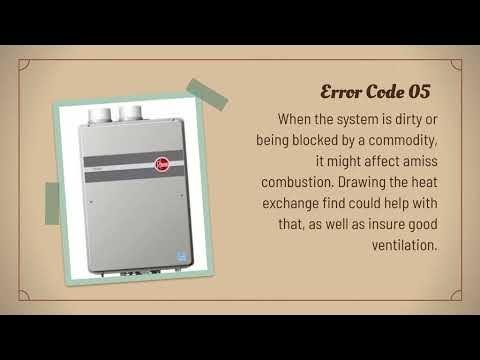
You might be wondering, “Is this error code something I can just brush off?” The short answer is no. Ignoring such an error code can lead to more than just cold showers. It’s like ignoring the check engine light in your car; it’s a warning sign that something needs fixing. In this article, we’ll dive deep into what the E2 error code means for your Rheem water heater. We’ll explain why it’s crucial to address it promptly and offer some guidance on what steps you can take to resolve it. So, let’s get into it!
Understanding Rheem Water Heater Error Codes
To really grasp why the E2 error code shouldn’t be ignored, let’s take a moment to understand what these error codes are all about. Rheem water heaters, much like other modern appliances, are equipped with smart diagnostics. This means that when something goes wrong, the heater doesn’t just stop working without explanation. Instead, it displays an error code. Think of these codes as a secret language of sorts — like how bees communicate with their waggle dances.
The E2 error code specifically indicates a problem with the heater’s thermistor. Now, you might be asking, “What in the world is a thermistor?” Imagine it as the thermostat for your water heater — it’s the sensor that measures water temperature and tells the heater when to heat up or cool down. If the thermistor isn’t working correctly, your water heater can’t do its job effectively. It’s like trying to bake a cake without knowing the oven temperature; you’d end up with a soggy mess or a burnt crisp.
Ignoring this error is risky because it can lead to inconsistent water temperatures, inefficient energy use, and even potentially damage other components of the heater. So, the next time you see an E2 error, treat it as a priority — like attending to a leaky faucet before it floods your kitchen.
Common Causes of Error Code E2
So, what typically causes an E2 error to pop up on a Rheem water heater? Well, there are a few usual suspects. First off, it could be a faulty thermistor, as we discussed earlier. It’s not uncommon for electrical components to wear out over time. Imagine the thermistor as a pair of socks — wear them too long without replacement, and they’re bound to develop holes.
Another potential cause could be loose wiring or poor connections. Just as a weak battery connection can prevent your flashlight from turning on, loose wiring can disrupt the communication between the thermistor and the heater’s control board. This can lead to incorrect error messages or prevent the heater from functioning at all.
Environmental factors, such as excessive humidity or temperature fluctuations, might also play a role in triggering this error code. Think of your water heater like a plant — it thrives under the right conditions, but too much or too little of something can throw it off balance. In any case, identifying the root cause is key to resolving the problem effectively.
If you suspect an E2 error, checking the connections or consulting with a professional can save you from bigger headaches down the road. Ensuring everything is in tip-top shape—like ensuring your car tires are inflated before a long trip—is the best preventive measure.
Consequences of Ignoring the E2 Code
You might be tempted to wave off the E2 error code, thinking you can live with lukewarm water or occasional cold showers. However, ignoring it can lead to more serious problems. First, there’s the risk of inconsistent water temperatures. Imagine expecting a warm shower after a long day, only to be jolted awake by ice-cold water — not fun!
Moreover, operating a water heater with a faulty thermistor can lead to inefficient energy usage. It’s akin to leaving lights on in an empty house; you’re still paying for the electricity, but it’s going to waste. This inefficiency can result in higher utility bills, something no one wants.
Over time, a persistent E2 error can cause wear and tear on other parts of the heater, potentially leading to premature failure. It’s like ignoring the strange sounds your car makes until the engine gives out. This could mean costly repairs or even needing a brand-new heater sooner than expected.
To prevent these consequences, it’s crucial to address the E2 error promptly. This might involve resetting the heater, checking connections, or calling a technician for help. Remember, proactive maintenance is always easier and cheaper than major repairs.
Fixing and Preventing Future Occurrences of Error Code E2
Now that we know the importance of addressing the E2 error, how do you go about fixing it? If you’re a bit handy, you might start by resetting your water heater. It’s a bit like rebooting your computer to fix minor glitches. If the error persists, inspecting the thermistor and its connections for any obvious signs of damage or disconnection is a good next step.
However, if you’re unsure or uncomfortable tinkering with your water heater, it’s wise to contact a qualified technician. They can ensure the problem is resolved correctly and safely — like calling a plumber for a persistently clogged drain.
To prevent future occurrences, regular maintenance of your water heater is key. Think of it like taking your car for regular oil changes to keep it running smoothly. This means periodically checking connections, ensuring the heater is in a suitable environment, and replacing parts as they wear out.
By taking these steps, you’re not only addressing the immediate problem but also extending the lifespan of your water heater. Just like a little tender loving care goes a long way with a favorite pair of shoes, the same applies here. With this approach, you can enjoy consistent hot water and peace of mind, day in and day out.